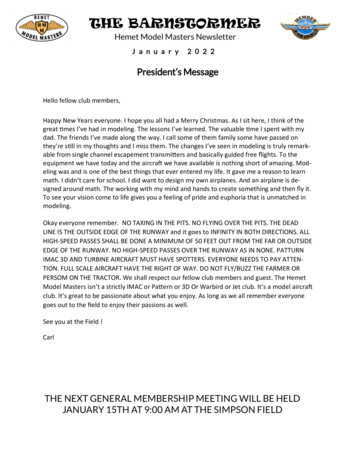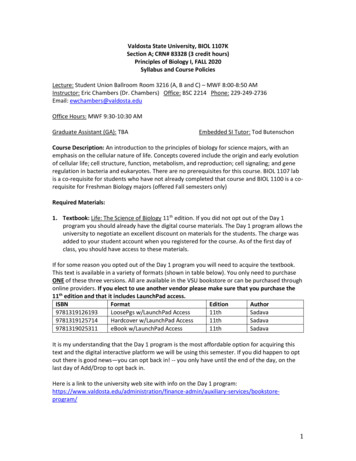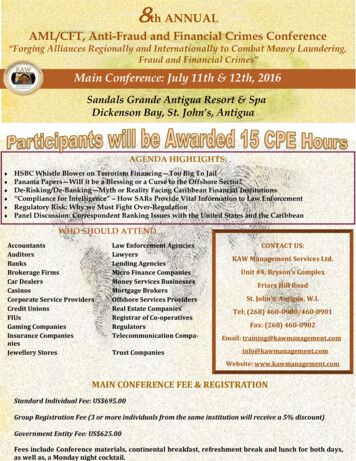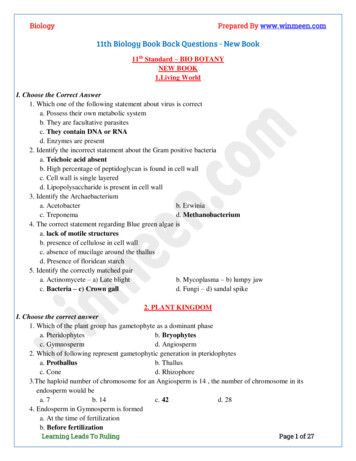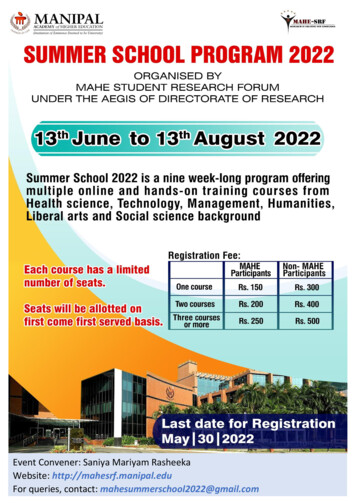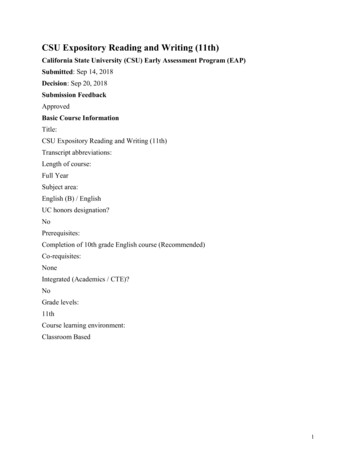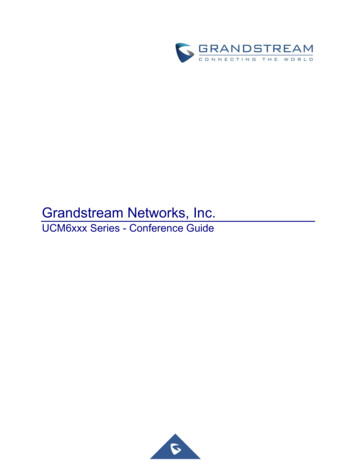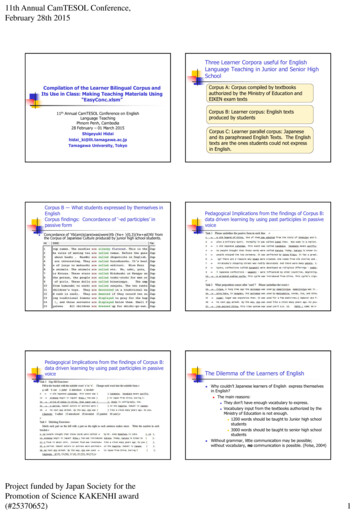
Transcription
11th Annual CamTESOL Conference,February 28th 2015Three Learner Corpora useful for EnglishLanguage Teaching in Junior and Senior HighSchoolCorpus A: Corpus compiled by textbooksauthorized by the Ministry of Education andEIKEN exam textsCompilation of the Learner Bilingual Corpus andIts Use in Class: Making Teaching Materials Using“EasyConc.xlsm”Corpus B: Learner corpus: English textsproduced by students11th Annual CamTESOL Conference on EnglishLanguage TeachingPhnom Penh, Cambodia28 February – 01 March 2015Shigeyuki Hidaihidai ki@lit.tamagawa.ac.jpTamagawa University, TokyoCorpus B ― What students expressed by themselves inEnglishCorpus findings: Concordance of ‘-ed participles’ inpassive form Corpus C: Learner parallel corpus: Japaneseand its paraphrased English Texts. The Englishtexts are the ones students could not expressin English.Pedagogical Implications from the findings of Corpus B:data driven learning by using past participles in passivevoiceConcordance of ‘ b(am is are was were) b ( w ){0,3}( w ed) b’ fromthe Corpus of Japanese Culture produced by junior high school students.Pedagogical Implications from the findings of Corpus B:data driven learning by using past participles in passivevoiceThe Dilemma of the Learners of English Project funded by Japan Society for thePromotion of Science KAKENHI award(#25370652)Why couldn’t Japanese learners of English express themselvesin English? The main reasons: They don’t have enough vocabulary to express. Vocabulary input from the textbooks authorized by theMinistry of Education is not enough. 1200 words should be taught to Junior high schoolstudents 3000 words should be taught to senior high schoolstudentsWithout grammar, little communication may be possible;without vocabulary, no communication is possible. (Folse, 2004)1
11th Annual CamTESOL Conference,February 28th 2015Theoretical background―Without input, output cannot be expected The relation between input and outputCorpus C―Six stages of Data Collection forJapanese-English Bilingual Corpus 1/2 (Ellis, 1997:35)It is very important to know what they couldnot express in English.How can we utilize what they wanted toexpress but couldn’t in English teaching?Corpus C―Six stages of Data Collection forJapanese-English Bilingual Corpus 2/2 Stage 4 Each question in Japanese from students is translatedinto English by Japanese teachers and native Englishspeaking teachers.Stage 5 Data of Japanese questions and their English translationsare incorporated into EasyConc v.2.0.xls.Stage 6 Some pieces of grammatical information are retrieved bycorpus tools in order to make worksheets for Englishclasses.Stage 1―Example of a communication activity in English Classfor the compilation of Japanese-English Bilingual Corpus Speaking Test called Interview Challenge Telling to the native English-speaking teacher about one lesson from thetextbooks authorized by the Japanese Ministry of Education Stage 1 Implementing communication activities in EnglishClasses.Stage 2 After the activities, students are asked to write theexpressions in Japanese that they wanted to use inEnglish but couldn’t during the activitiesStage 3 Each question in Japanese from Students is input intoeach cell on Excel spreadsheet.Stage 1―Example of a communication activity in English classfor the compilation of Japanese-English Bilingual Corpus Data Collection: Chat in pairs about weekends and holidaysStage 2 to 5―Compilation of Japanese-English Bilingual Corpus:Matching each Japanese expression with its Englishtranslation on an Excel spreadsheet Translation from Japanese expressions into English inassociation with a native speaker of English Copyright restricts the display of images here. Last 13 examples out of 2895 questionsfrom junior & senior high school studentsProject funded by Japan Society for thePromotion of Science KAKENHI award(#25370652)2
11th Annual CamTESOL Conference,February 28th 2015Stage 6―Pedagogical Implication: Supplying learners withEasyConc v.2.0.xlsm as a production dictionary Stage 6―The result of the retrieval: English sentences includingJapanese keywords ‘勝’ or ‘負’.Using EasyConc v.2.0.xlsm as a Japanese-English dictionarySearching for English sentences using Japanese keywordsStage 6―Pedagogical Implication: Supplying learners withEasyConc v.2.0.xlsm as a production dictionary Stage 6―The result of the retrieval: English sentences includingEnglish keywords ‘win’, ‘wins’, ‘winning’, ‘won’, ‘lose’,‘loses’, ‘losing’, or ‘lost’.Using EasyConc v.2.0.xlsm as a English-Japanese dictionarySearching for English sentences using English keywordsExtracts from the retrievalThe input of ‘lose’ and its conjugation from NewCrown English Series Book 1, 2 and 3, theauthorized textbooksConcordance of ‘( blose b bloses b blost b)’ from New Crown English SeriesBook 1, 2 and 3Corpus finding 1: lexical verb ‘lose’ retrievedfrom EasyConc v.2.0.xlsmConcordance of ‘lose’, ‘loses’ and ‘lost’ from EasyConc v.2.0.xlsm.There are only two sentencesretrieved from New CrownEnglish Series Book 1, 2 and 3for junior high school students!Partial extract from the resultProject funded by Japan Society for thePromotion of Science KAKENHI award(#25370652)3
11th Annual CamTESOL Conference,February 28th 2015Pedagogical Implication 1: Ideas for creatingteaching materials for English classCreating a short story by using three words, such as ‘play’, ‘win’, ‘lose’.The input of ‘because’ and ‘while’ from NewCrown English Series Book 1, 2, and 3, theauthorized textbooksConcordance of ‘while’ and ‘because’ from New Crown English Series Book 1, 2 and3Corpus finding 2: subordinating conjunctions,‘because’Corpus finding 3: subordinating conjunctions,‘while’Concordance of ‘なので’, ‘だから’, ‘原因で’, ‘理由’, ‘ために’, ‘のせいで’ from EasyConc v.2.0.xlsmConcordance of ‘ながら’ from EasyConc v.2.0.xlsmPartial extract from the resultPartial extract from the resultPedagogical Implication from corpus finding 2&3: Getting students to be familiar withsubordinating conjunctionsGapfill exercises: Fill in the each bracket with a suitable linking wordin the box.1. I am very sleepy () I was reading all night long.2. I read a book () listening to music.3. I went shopping () I wanted to buy a birthday present for myfriend, Yukikobecause / while / if4. I eat dinner () watching TV.The input of the post modification of relativepronoun ‘that’ from New Crown English Series,the authorized textbooksConcordance of ‘that’ from New Crown English Series Book 3Matching Exercises: Use a linking word in Box B to match the sentence partsin boxes A and C.Box ABox Bbox C1. I was eating1. I can't play thepiano wellspaghetti.because2. I watched the2. it stars my favoritenewswhileactor.3. I wanted to seethe movie3. I am a beginner.Project funded by Japan Society for thePromotion of Science KAKENHI award(#25370652)4
11th Annual CamTESOL Conference,February 28th 2015Corpus finding 4: postmodification by relativeclausesPostmodification doesn't exist in Japanese language.Concordance of ‘買’, ‘欲’ from EasyConc v.2.0.xlsmPartial extract from the resultConclusion It is important for teachers to know the expressions thatlearners want to use in English but can’t through communicationactivities in your English classes.Why don’t you compile bilingual corpus for your students? Itwill be a useful resource for your teaching.Bilingual corpus software such as EasyConc v.2.0.xlsm is easyto get from the Internet. Without that software, it would beimpossible to retrieve necessary information from bilingualcorpus.If you change Japanese data of EasyConc v.2.0.xlsm to yourmother tongue, you can create your own corpus. If you addyour data to EasyConc v.2.0.xlsm, you can create your ownEasyConc v.2.0.xlsm.Pedagogical Implication 4: Getting studentsused to postmodification by relative clausesWhile working on the exercises below, Learners of English areexposed to frequently used expressions in communicativeactivities. Sentences in the exercise below are all fromEasyConc v.2.0.xlsm.A sample word order exercise:Put the words in the brackets in the right order.1. I couldn't buy (a / wanted / book / I) in the bookstore.2. That is (the / wanted / which / I / have / book) for a long time.3. I went to the bookstore but I couldn't (find / books / I / any /wanted).4. I went to the CD shop but I couldn't (one / I / which / wanted /find / the).5. (one / I / of / accessories / bought) was 400 yen.References太田洋・日臺滋之. 2006.『新しい語彙指導のカタチ ��.日臺滋之・太田洋. 滋之. 2009.『中学 013年4月1日 �究(C) 日臺滋之)Retrieved thony, L. 2011. AntConc (ver 3.2.4w) [Computer Software]. Tokyo, Japan: WasedaUniversity. Retrieved from lse, S. Keith. 2004. Vocabulary Myths. The University of Michigan Press.Hidai, Shigeyuki.2015.EasyConc v.2.0.xlsm [Computer Software]. Tokyo, Japan:Tamagawa University. Retrieved from elton, D. ・日臺滋之. 50 Skits for LearningEnglish―』. 明治図書.Nation, I.S.P. 2001. Learning Vocabulary in Another Language. Cambridge UniversityPress, Cambridge.Quirk, R., S. Greenbaum, G. Leech and J. Svartvik. 1985. A Comprehensive Grammarof the English Language. London: Longman.Takahashi, S, et al. 2011. New Crown English Series. Sanseido.Tribble, C., & Jones, G. 1997. Concordances in the classroom. Houston, TX:Athelstan.Thank you for your attention.Shigeyuki HidaiTamagawa University, Tokyo, JAPANhidai ki@lit.tamagawa.ac.jpProject funded by Japan Society for thePromotion of Science KAKENHI award(#25370652)5
authorized by the Ministry of Education and EIKEN exam texts Corpus B ― What students expressed by themselves in English Corpus findings: Concordance of '-ed participles' in passive form Concordance of ' b(am is are was were) b ( w ){0,3}( w ed) b' from the Corpus of Japanese Culture produced by junior high school students.
